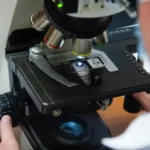Solution for histology.
Kits TML-LAB1 and TML-LAB2 (labels + ribbon) for marking slides in histology.
The labels are resistant to xylene and other compositions.
For printing with thermal transfer printers Zebra, cab, Toshiba, Citizen, etc.
• Approved and used by laboratories.• Produced by TML-LT in accordance with ISO-9001, always in stock.• Compact rolls and perforations between labels for easy handling!
KITS
| SKU | Description | Label size |
|---|---|---|
| TML-LAB1 | TML-LAB1 kit for Zebra mini printers | 19*19 mm |
| TML-LAB1-mini | TML-LAB1 kit for narrow format Zebra mini printers | 19*19 mm |
| TML-LAB1-PRO | TML-LAB1 kit for cab printers | 19*19 mm |
| TML-LAB2 | TML-LAB2 kit for Zebra mini printers | 24*19 mm |
| TML-LAB2-mini | TML-LAB2 kit for narrow format Zebra mini printers | 24*19 mm |
| TML-LAB2-PRO | TML-LAB2 kit for cab printers | 24*19 mm |
Content of the kit:
• 2 rolls of 1700 labels
• 1 ribbon, 76 meters (core diameter 12.7 or 25.4 mm – please, specify your printer model on order).
TASK
• Unmistakably identify the studied samples of biomaterials
• Print labels from the laboratory’s electronic database.
LABELING REQUIREMENTS
• Clear, legible print
• Marking resistance to multiple washes and prolonged exposure to aggressive solvents (xylene, toluene, alcohol, hexane, acetone, etc.)
• Reliable adhesion of the label to the plastic and glass surfaces
• The surface of the label should not be stained when processing the sample with a coloring agent
• Durability – the label must remain legible for several years.
SOLUTION
Information is printed with a compact thermal transfer printer integrated into the laboratory’s information system. At the beginning of the study the printed self-adhesive labels are applied to the surface of a microscope slide or material cassette.
MATERIALS
Chemical resistant polyester 2213 labels with B110CU ribbon (thermal transfer ink ribbon) are the only combination to withstand acetone and xylene. Operating temperature from -40°С to + 150°С.
PRINTING EQUIPMENT
We recommend compact and reliable printers made by cab (Germany), models EOS2 and EOS5:
• print from electronic databases
• print on small labels
• support printing mode for maximum resistance to highly aggressive solvents.
Our kits of labels and ribbons are also suitable for printing with printers from other manufacturers.
Additional print quality testing will be required.
OPTIONS
• Production of marking kits for Leika marking equipment
• Production of sets (labels) – any size
• Labels for material cassettes – tests required.
Main characteristics of 2213 label material
| Main application | Identification label |
| Informative tag for identification of various equipment, instruments and other long-term use products exposed to particularly aggressive solvents (including acetone and ortho-xylene). The material is resistant to xylene, toluene, ethanol, autoclaving (+150°C). It can be applied on rough (powder coated) and low-energy surfaces. Main consumers: the automotive, chemical industry, medicine, aviation, instrument engineering enterprises, electronics, and other industrial manufacturers. The material has been successfully tested in advanced oncology diagnostic laboratories. | |
| Material type | Polyester, 50 microns |
| High chemical resistance. The most popular material type for marking industrial products. Stands out for high wear resistance, resistance to moisture, solvents and fading. | |
| Operating temperature | From -40°С to +150°С |
| The constant exposure of this temperature does not change the properties and appearance of the label. | |
| Adhesive (adhesive layer) | Reinforced, 20 microns |
| Reinforced acrylic adhesive polymerising under pressure. | |
| Color and appearance | White glossy |
| Does not glare, does not reflect, does not fade. Provides high contrast of barcodes and graphics. | |
| Surface coating | |
| The smooth covering is suitabe for the thermotransfer printing using ribbon B110CU (see recommended ribbons). It is recommended to use low print speed and high printing heat in order to achieve maximum chemical resistance | |
| Labeling recommendations | |
| For best result, it is recommended to apply the label on a clean, degreased, dry surface, press or roll it with a rubber roller, and incubate for 24 hours at room temperature. | |
Main Features of B110CU Ink Ribbon
| The main material | Polyester (PET) |
| Base thickness | 4,5 μm ± 0,4 μm |
| Ink thickness | – |
| Total thickness | Less than 9 μm |
| Print density | 1.65 (white polyester) 1.81 (white polypropylene) More than 1.5 (on synthetic labels with a different color) |
| Ink melting point | 112 ° C |
| Thermal image resistance | Up to 250 ° C (on polyester) |
| Maximum print speed | 100 mm / sec. (Depending on media and image, minimum print speed is recommended) |





